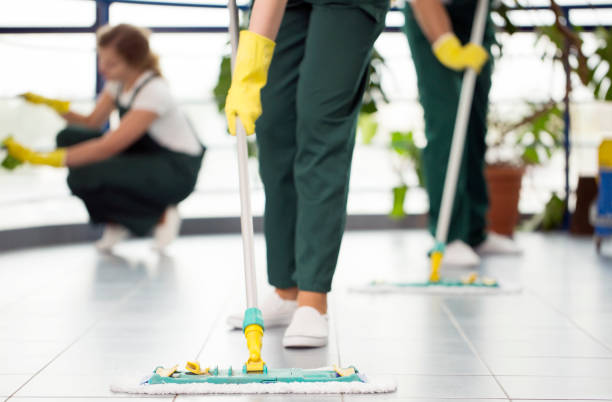Why Clean Floors Matter A Lot in Medical Facilities
Imagine walking into a hospital and noticing the floor looks like it hasn’t seen a mop in a fortnight! Yuck, right? You’d be questioning whether the place is serious about health. In medical facilities, cleaning commercial floors is paramount. Here’s why you should never turn a blind eye to it.
Floors are playgrounds for bacteria and viruses. Every person tracking through brings in dirt and pathogens. If these aren’t handled, they’re like time bombs waiting to go off. Think of it—patients already deal with enough without worrying about what’s brewing beneath their feet. Clean floors act almost like silent guardians, shielding everyone from invisible enemies.
But hold on, it’s not just about dirt and bugs. Safety’s another huge factor. Imagine the chaos a spill could cause in a busy corridor. Slip and falls aren’t just comedy fodder—they’re real risks, especially for patients who might already have mobility issues. Regular, thorough cleaning minimizes these hazards. It’s like having guardrails on a winding road—preventive yet essential.

Moreover, let’s face it: appearance matters. Who wants to trust their life to a clinic that looks like it belongs in a horror movie? A sparkling clean floor is a visual reassurance that the place takes health seriously. It helps in fostering confidence among patients and visitors alike. It’s similar to how a smile can put someone at ease; clean floors exude a positive vibe.
Beyond these points, consider the lifespan of the flooring materials. High foot traffic in hospitals wears out floors quicker than in many other places. Regular cleaning isn’t just an activity; it’s like giving those floors a nourishing elixir, extending their life. This way, the facility saves money in the long run on replacements and repairs. Sort of like brushing your teeth to avoid cavities and expensive dental work later on.
Then there’s the psychology of cleanliness. Dirty floors can ruin morale for both staff and patients. It’s akin to having a thorn in your shoe all day—annoying and distracting. Conversely, a clean environment boosts mood and productivity. When staff members see a clean space, they’re likely to take more pride in their work. Consequently, it leads to a ripple effect, positively impacting patient care.
And don’t forget, regulations and health code compliance are built around cleanliness. Falling short can rake up fines and damage reputation. Hospitals can’t afford that hit, especially with so many eyes watching.
Let’s sprinkle in a true story for flavor. A small community hospital once found itself at odds with rising infection rates. Consultants bombarded them with suggestions—more isolation rooms, higher patient screening. But the solution came from a new janitorial service. They amped up their floor-cleaning protocols, paying extra attention to frequently used areas. Lo and behold, infection rates dropped significantly.
Here’s something even you might not know: clean floors can improve air quality. Dust, dander, and assorted particles settle on surfaces. They get swept back into the air when disturbed. Regular floor cleaning acts like a filter, capturing all that muck before it can float around. Makes you appreciate clean floors even more, doesn’t it?
Let’s not weather the topic to the bone, but there’s also the element of patient satisfaction. Hospitals often receive feedback on the environment. A clean, immaculate floor can be the unsung hero in glowing reviews. People notice details. Ensure the small stuff is taken care of, and you’ll see the bigger advantages unfold naturally.
Eco-Friendly Ways to Disinfect Hospital Floors Without Harsh Chemicals
Let’s talk about cleaning commercial floors, especially in hospitals. It’s often seen as this Herculean task that requires tough chemicals. Stick around because we’re diving into some astonishing methods to keep hospital floors squeaky clean and germ-free without those pungent chemical cleaners.
First off, think steam. They shoot out hot steam that obliterates germs right on contact. You kill two birds with one stone – you get a sparkling floor and an enemy-free zone for bacteria. Plus, no smelly residues, just the fresh scent of cleanliness.
Vinegar is another underrated gem. Before you wrinkle your nose, hear me out! This kitchen staple is superb at cutting through grime. Add a few drops of essential oil, and bam, you’ve also got a naturally pleasant fragrance wafting through the ward. It’s like killing bacteria while spraying good vibes in the air!
Another golden nugget: ultraviolet (UV) light. Hospitals are already using this tech to disinfect their equipment, so why not the floors? Pass a UV light-emitting device over the floor, and it annihilates bacteria at the speed of light. It’s efficient, effective, and oddly satisfying to watch. Plus, there’s something cool about using light to clean, don’t you think?
Microfiber mops might sound boring, but these bad boys pack a punch. They trap dirt and germs, unlike traditional mops which just sort of spread it around. Think of them as magnets for microbes. Wash them in hot water, and they’re ready to battle grime again. No need for chemical reinforcements here!
Consider also switching up floor treatments. Polishing and waxing those floors with more environmentally friendly substances can create surfaces that repel grime longer. It’s like giving your floors an invisible superhero cape. They stay cleaner, and you’re not using toxic potions to shine them.
Ever heard of electrolyzed water? It’s plain old H2O, zapped with electricity to create a cleaning solution that’s as fierce as bleach but much kinder to the planet and your lungs. Imagine turning tap water into a chemical-free, germ-busting solution. That’s science fiction turned reality.
Speaking of turning heads, how about plant-based cleaners? These aren’t just for hippies anymore. They’re scientifically formulated to kick germs to the curb while being gentle on the earth. Companies are brewing up concoctions that are tough on bacteria but soft on pretty much everything else. Give peas a chance!
Even robots can lend a hand—or a wheel? Autonomous cleaners are rolling into hospitals and taking over floor duties. These robo-janitors zip around, scrubbing and disinfecting without needing a coffee break. And they don’t complain, which in my book, is a win-win.
If you’re thinking, “What about heavy-duty spills and stubborn dirt?” Relax, it’s all in the elbow grease and the right tool. Scrubbers powered by plain water but with robust mechanical actions can make short work of stains and spills without drenching everything in chemicals.
Natural enzyme cleaners are also something worth mentioning. These use enzymes to break down organic material. They’re like little Pac-Men gobbling up the grime, turning dirty floors into squeaky-clean ones minus the harsh chemical fallout.
Lastly, air purification systems that also target floor surfaces. Combining them with your standard cleaning routines can further reduce the need for caustic chemicals. It’s like attacking germs from the ground up and the air down simultaneously. Smart, right?






